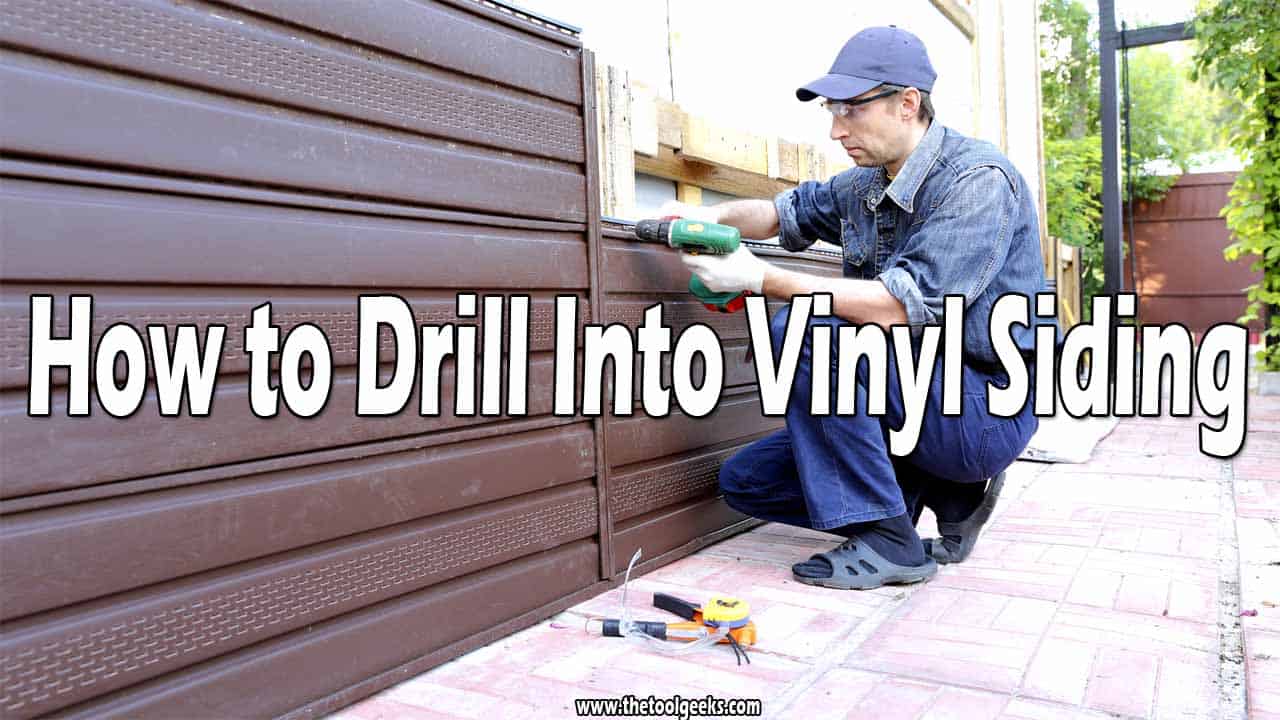How to Drill Into Vinyl Siding? – 6 Easy Steps
TheToolGeeks.com is a participant in the Amazon Services LLC Associates Program and other affiliate advertising programs. We may earn from qualifying purchases. (Learn More).
Mostly vinyl siding is chosen for exterior finishing. It is durable and low maintenance. But if you need something to be hung on the wall, you will need a drill to get through the vinyl siding.
Drilling into vinyl siding isn’t very difficult itself. However, some precautions need to be attended to first. This type of siding is durable, practical, and has several benefits.
But one error with drilling can result in many expensive repairs. That’s why we’re here with a detailed guide on how to drill into the vinyl siding.
Jump To Page Contents:
Is It Okay to Drill Into Vinyl Siding?
Yes, you can drill into the vinyl siding. But there are some things you need to know before drilling. The best time to do drilling is in warm weather. Most of the time, vinyl siding brittles more when the weather is cold.
You can risk it shattering in the frigid temperature. The outside temperature should not exceed 60 F (15 degrees Celsius).
Which Drill and Bits should you use for Drilling Vinyl Siding?
Vinyl siding is not rigid; any standard cordless drill will do your job. Regarding drill bits, The length of the drill bit for drilling the vinyl siding should be long because it has a wall behind it. (So, make sure not to use an already used bit, which is not very lengthy)
The wooden bit will be ideal if the structure behind the vinyl is wood, and if it is concrete or brick, then the best choice will be a masonry bit (carbide material).
The drill bit’s size depends on the hole diameter you want to drill. The best practice is determining your requirements and then choosing the drill bit.
You can learn more about drill bit sizing here.
How to Drill Into Vinyl Siding? – Easy Steps
1. Gather Tools & Clear the surrounding area
As with any home improvement project involving power tools, the first step is to clear the workspace. Since this involves working outside, cleaning the areas and ensuring the kids and pets are away from the space you will be working in is essential.
The things you may need to drill into vinyl siding are:
- Helping hand to help you to pass the screws or hold the ladder (if required).
- Safety goggles: Pieces of vinyl spread around, so it is helpful to keep your eyes safe.
- Earplugs: If you’re sensitive to noise.
- Gloves to ensure the safety of your hands.
- Ladder, in case you’re working on a height (you can use a stool or chair too).
- Standard cordless drill – It’s a primary tool for the whole project.
- Drill bits (We have discussed the type and size of drill bits already)
- Marker
- Measuring tape
Related Read — Best Battery-Powered Drills Review
2. Locate and mark the drill point
You need to locate the point you are going to be drilling. For this purpose, use a pen or a marker to mark an area you will drill.
In case you plan on drilling multiple holes, mark all required holes now instead of coming back to this step again later. It’s best to have everything ready to go, so it’ll be a quick sequence of drills when you begin drilling.

3. Attach the drill bit to the Drill Machine
As mentioned before, the material or the length helps decide the brit. When the sheathing is identified, we can choose the right drill bit type to attach to your drill. Using the wrong type, size, or shape can damage the bit and the siding.
How to attach it?
- Locate the chuck at the end of the drill. The chuck is the part that holds the drill bit.
- Turn the chuck counterclockwise with your hand to loosen it.
- The drill bit should be inserted into the chuck. Ensure the drill bit’s shank is aligned with the chuck’s jaws.
- Turn the chuck clockwise to tighten it. To prevent the drill bit from slipping, ensure it is tightened securely.
- If your drill has a keyed chuck, you must use a chuck key to tighten the chuck.
4. Determine the Sheathing
Before piercing the siding, we must examine the sheathing— the material beneath the siding. Usually, there is insulation immediately behind the siding, then some form of a framing structure beyond that.
The framing structures can be brick or concrete, but most often, wood. Determine what is behind the surface you’re planning to drill into. Ensure no pipes, electrical wiring, cables, or anything else are in the way.
5. Start Drilling
Place your cordless or corded drill on the designated mark for the hole, and turn it on using a button on the handle. Make sure to drill steadily with pressure, but don’t apply too much force, as it may ruin your vinyl sheet.
The drill should remain perpendicular; any other angles will result in incorrect drilling.
Stop:
Keep drilling until you puncture the siding, pass through the insulation, and hit the material underneath. Then pulse the drill a bit to help you pierce that material. Drill less than ½ of an inch into the wood. That will allow your screw to have something to grip onto.
Stop drilling at this point! Stay away from the framing structure. You only want to drill enough for some grip for your screw.
Related Read — How to Drill Into Bricks?
6. Reverse, Clean & Check
Reverse the directions of the drill as you pull it outward. It will cut faster in reverse because the teeth of the grill won’t grab onto the plastic. So it “melts” rather than “cuts” the vinyl.
Clean: Remove any debris from the drilling, and check closely for damages or cracks.
Continue drilling the subsequent holes.
Repeat these steps with all. It’s best to drill together. In between holes, check to see if the drill bit hasn’t loosened from work. Retighten it if necessary.
Related Read — How Long Do Drill Bits Last?
Tips & Tricks About Drilling Into Sidings
Do Not Drill Into Vinyl in Cold Temperatures
Vinyl siding can be prone to breaking. Especially if the temperature is cold, it will crack! Experts recommend waiting until the weather is 60 degrees F or more to prevent this brittle material from shattering.
Also, older vinyl is even more likely to crack under cooler temperatures. It’s a good idea to wait for the weather to become warmer before beginning a drilling project for vinyl siding.
Nonetheless, if waiting is not an option, you can use a hairdryer to heat the vinyl siding at the location where you’ll be drilling. That is more time-consuming, and you’ll have to heat each new site before drilling each hole.
Related Read — How to Drill Into a Lock?
Drilling Alternatives
It’s best first to consider alternatives than resort to drilling. Depending on whether the attachment will be permanent, you can use heavy-duty tape, glue, or epoxy. Most decorations are seasonal and lightweight, so this temporary option is a good alternative.
Other possibilities are to use siding hooks or clips. These can be mounted, but you might need to play with them to sit however you want.
These inexpensive alternatives won’t leave any ugly holes in your vinyl siding, but they might not be able to endure the weight of what you’re mounting either.
Related Read — How to Drill Into a Stud?
Safety First
Drilling can be a dangerous job. For this project specifically, there is more than one occasion to recommend having someone to assist you.
But the most prominent situation is ladder safety. Drilling into siding can often be to hang decorations or cameras, or even flag poles. Any of these will require a ladder. Having helping hands is essential to make sure your ladder is sturdy.
Conclusion
While drilling, you need to use the proper drilling machine. A wrong one will damage the vinyl siding and end up causing trouble. Ensure to choose the appropriate machine and drill bit to drill into the vinyl siding.
Safety measures and proper holding are also essential while drilling on the vinyl siding. Follow the steps, tips, and tricks we discussed in the article to get your desired results.
FAQs
How do I prevent the siding from cracking while drilling?
Use a drill bit slightly smaller than the screw or anchor you are using, and apply steady pressure while drilling.
Can I use regular screws to attach things to vinyl siding?
No, regular screws may damage the vinyl siding. Use screws or anchors specifically designed for vinyl siding.
Amazon and the Amazon logo are trademarks of Amazon.com, Inc, or its affiliates.

